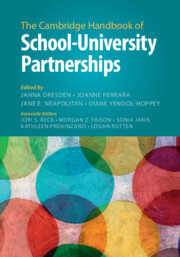Book contents
- The Cambridge Handbook of School–University Partnerships
- The Cambridge Handbook of School–University Partnerships
- Copyright page
- Contents
- Figures
- Tables
- Contributors
- Foreword
- Preface
- Acknowledgments
- Part I The History and Conceptual Foundations of School–University Partnerships
- Introduction to Part I: The History and Conceptual Foundations of School–University Partnerships
- 1 Origins
- 2 The Legacy of John I. Goodlad (1920–2014)
- 3 More Commonalities Than Differences
- 4 From Holmes to Here
- 5 Theorizing Partnership Work
- 6 The Metaphors We Partner By
- 7 Commentary: Focus versus Locus
- 8 Commentary: From Mission to Metaphors and Questions in Between
- 9 Commentary: Historical Perspectives and Conceptual Foundations of School–University Partnerships
- Part II Teachers and Learning to Teach in School–University Partnerships
- Part III Equity and Student Learning in School–University Partnerships
- Part IV Leadership in School–University Partnerships
- Part V Community Schools as School–University Partnerships
- Part VI Inquiry and Innovation in School–University Partnerships
- Part VII Funding, Policy, and the Politics of School–University Partnerships
- Part VIII Looking at School–University Partnerships across Geographic and Cultural Borders
- Index
- References
4 - From Holmes to Here
A Retrospective on Educator Race and Ethnic Diversity in School–University Partnership Research
from Part I - The History and Conceptual Foundations of School–University Partnerships
Published online by Cambridge University Press: 05 November 2025
- The Cambridge Handbook of School–University Partnerships
- The Cambridge Handbook of School–University Partnerships
- Copyright page
- Contents
- Figures
- Tables
- Contributors
- Foreword
- Preface
- Acknowledgments
- Part I The History and Conceptual Foundations of School–University Partnerships
- Introduction to Part I: The History and Conceptual Foundations of School–University Partnerships
- 1 Origins
- 2 The Legacy of John I. Goodlad (1920–2014)
- 3 More Commonalities Than Differences
- 4 From Holmes to Here
- 5 Theorizing Partnership Work
- 6 The Metaphors We Partner By
- 7 Commentary: Focus versus Locus
- 8 Commentary: From Mission to Metaphors and Questions in Between
- 9 Commentary: Historical Perspectives and Conceptual Foundations of School–University Partnerships
- Part II Teachers and Learning to Teach in School–University Partnerships
- Part III Equity and Student Learning in School–University Partnerships
- Part IV Leadership in School–University Partnerships
- Part V Community Schools as School–University Partnerships
- Part VI Inquiry and Innovation in School–University Partnerships
- Part VII Funding, Policy, and the Politics of School–University Partnerships
- Part VIII Looking at School–University Partnerships across Geographic and Cultural Borders
- Index
- References
Summary
Nearly thirty years ago, the Holmes Partnership Group (1995) envisioned educators of color as essential to school–university partnerships (SUPs), to the transformation of teacher education, and to achieving equity in public schools. This chapter asserts that the Holmes Partnership Group linked together culture, pedagogy, and the proportional representation of educators of color as a core conceptual foundation of SUPs. Using their final report, Tomorrow’s Schools of Education, as a key SUP policy and governance document, the author provides a retrospective examination of literature on today’s racially and ethnically diverse PK-20 educator pipeline as connected to the goals of cultural pluralism within a democracy and equitable access and opportunity in student learning. The chapter concludes with implications for future research that connects SUPs, social justice teacher education, and the well-being and sustainability of educators of color.
Keywords
Information
- Type
- Chapter
- Information
- The Cambridge Handbook of School–University Partnerships , pp. 65 - 80Publisher: Cambridge University PressPrint publication year: 2025
References
Accessibility standard: WCAG 2.1 AA
Why this information is here
This section outlines the accessibility features of this content - including support for screen readers, full keyboard navigation and high-contrast display options. This may not be relevant for you.Accessibility Information
Content Navigation
Allows you to navigate directly to chapters, sections, or non‐text items through a linked table of contents, reducing the need for extensive scrolling.
Provides an interactive index, letting you go straight to where a term or subject appears in the text without manual searching.
Reading Order & Textual Equivalents
You will encounter all content (including footnotes, captions, etc.) in a clear, sequential flow, making it easier to follow with assistive tools like screen readers.
Visual Accessibility
You will still understand key ideas or prompts without relying solely on colour, which is especially helpful if you have colour vision deficiencies.
Structural and Technical Features
You gain clarity from ARIA (Accessible Rich Internet Applications) roles and attributes, as they help assistive technologies interpret how each part of the content functions.
